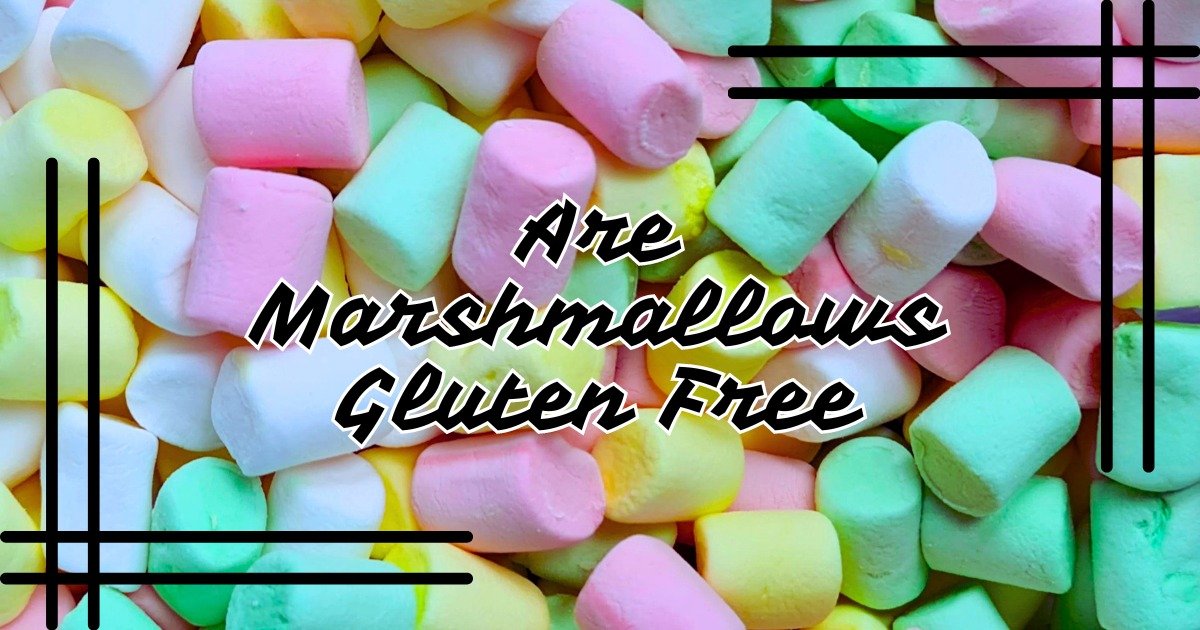What Is Gluten?
Gluten is a type of protein found in wheat. It’s also in rye and barley grains. Many foods like bread, cake, and cookies have gluten. Some candy and snacks may also contain gluten. Gluten helps food feel soft and chewy. But gluten can make some people very sick. People with celiac disease must avoid it always. Even a tiny bit of gluten can hurt them. Others have gluten sensitivity, which also causes health issues. That’s why reading food labels is very important. Snacks and treats should be clearly marked gluten-free. This helps keep sensitive people healthy and safe. Many ask, are marshmallows gluten free, and the answer depends. Some are safe, but some may hide gluten. It’s important to know which marshmallows to pick. Learning about gluten helps make better food choices. Knowing what’s safe means happy tummies and no pain. So, understanding gluten is very helpful for everyone.
What Are Marshmallows Made Of?
Marshmallows are made from sugar, water, and gelatin. These ingredients are usually gluten-free. They don’t come from wheat or barley. Corn syrup is added to make them sweet. Gelatin gives marshmallows their soft, bouncy feel. Some also have vanilla flavor or cornstarch. These things are also gluten-free. Most marshmallows have very simple ingredients. But not all are made the same way. Some brands add extra stuff for flavor. Others use factories that also process wheat. This is how gluten can sneak into candy. That’s why label reading is very important. If the bag says “gluten-free,” it is safer. It means the marshmallows were made more carefully. That label helps people make good choices. Always check before eating any new brand. Some marshmallows look safe but are not.
Are All Marshmallows Gluten-Free?
Most marshmallows are gluten-free by ingredient. They don’t usually have wheat, rye, or barley. But not every brand is completely safe. Some are made in places that also use gluten. This is called cross-contamination. Even small crumbs can make people sick. That’s a big risk for people with celiac disease. Their bodies can’t handle any gluten at all. So, even safe-looking candy might be dangerous. Some brands don’t test or label their products. That makes it hard to know if they are safe. Look for marshmallows with “gluten-free” printed clearly. These are made in clean, safe places. They are checked to be free from gluten. Trusted brands are better for gluten-free diets. Always read the label before buying a new bag. That keeps you safe and helps avoid problems.
Cross-Contamination: The Hidden Danger
Cross-contamination means mixing safe food with unsafe food. It happens when gluten touches gluten-free snacks. This can be very dangerous for sensitive people. Even tiny crumbs can hurt their stomachs badly. In candy factories, wheat may be in the air. Machines may touch wheat before making marshmallows. That’s how gluten can get in by mistake. Some brands clean their tools between candy batches. Others do not, and that’s a big problem. That’s why cross-contamination is a hidden danger. You can’t see it, but it’s there. If you have celiac disease, always be careful. Cross-contamination can sneak into sweet treats easily. Only buy marshmallows made in gluten-safe places. It’s the best way to avoid getting sick. Always read labels and pick trusted candy brands.
How to Know If Marshmallows Are Gluten-Free
Always look at the marshmallow package first. See if it says “Gluten-Free” on the bag. That label means the candy passed safety checks. It was made in a clean, gluten-free place. Also check the ingredient list on the back. If you see wheat, barley, or rye, avoid it. Some packs say “may contain wheat” – skip those. That means the marshmallows touched gluten somewhere. If you can’t find the label, don’t risk it. Pick a brand that clearly says “safe for celiacs.” Trusted brands often put safety info in bold. When in doubt, search the company website online. They may list how their candy is made. Look for allergy-friendly symbols on the front. Those signs help you make safer snack choices.
Best Gluten-Free Marshmallow Brands in 2025
Not all marshmallows are tested for gluten. But some brands make very safe and yummy treats. These are trusted by gluten-free families and kids. Each one is made in a gluten-free facility. Here are the top marshmallow brands for 2025:
| Brand Name | Why It’s Safe |
|---|---|
| Dandies | 100% vegan and gluten-free certified |
| Campfire | Clearly labeled gluten-free on packaging |
| Jet-Puffed | No gluten ingredients, made in clean areas |
| Trader Joe’s | Lists allergens, great gluten-free pick |
| Smashmallow | Fun flavors, gluten-free promise included |
| Whole Foods 365 | Organic and marked safe for gluten diets |
| Kroger Brand | Lists no wheat, labeled for food allergies |
| Sweet & Sara | Vegan, handmade, and gluten-free friendly |
These brands are safe and taste really good too. You can roast them or eat them straight. They’re fun in cocoa or mixed with cereal. Always double-check the label before buying new ones. Even trusted brands should be checked every time.
What Brands to Avoid If You Have Celiac
Not all marshmallow brands are safe for celiac people. Some do not have a “gluten-free” label on the bag. This means they could be made in places that use wheat. These brands might not add wheat, but still be risky. Look out for warnings like “may contain wheat” or “shared equipment.” That means gluten could have touched the marshmallows. If the label is unclear, skip that brand. Celiac disease needs extra care with hidden gluten spots. Even small bits of gluten can hurt your stomach. Stick with trusted brands that clearly say “gluten-free.” Avoid candy that gives mixed or confusing information.
Can People With Gluten Sensitivity Eat Marshmallows?
Yes, but they must read every label before eating. Some brands are safe while others may not be. Look for certified gluten-free signs on the front. These show that the candy meets strict gluten rules. If it’s not labeled, don’t take the risk. People with gluten intolerance can get sick easily. Their tummies can hurt or feel upset. Gluten-sensitive people should choose clean, simple candy. Avoid flavored ones with cookie or cereal pieces. Those might sneak in wheat or barley. Pick plain marshmallows from trusted gluten-free companies. That way, your snack is safe and still sweet.
How to Make Homemade Gluten-Free Marshmallows
You can make safe marshmallows right in your kitchen. Homemade ones use easy-to-find ingredients like sugar and water. You’ll also need corn syrup, gelatin, and vanilla. First, soak the gelatin in water to make it soft. Then boil sugar and corn syrup until it’s bubbly. Pour the hot mix into the gelatin slowly. Use a mixer to whip everything until it looks fluffy. After that, add vanilla and mix again. Pour the fluff into a pan with powdered sugar. Let it sit until it turns firm and squishy. Cut it into cubes and dust with more sugar. Now you have soft, gluten-free marshmallows to eat.
Vegan Marshmallows: Are They Also Gluten-Free?
Yes, most vegan marshmallows are also gluten-free treats. They do not have gelatin, which comes from animals. Instead, they use plant-based gelling agents like agar. Many brands also skip wheat and barley products. That makes them good for vegan and gluten-free diets. One great choice is Dandies marshmallows, a top vegan brand. They are fluffy, sweet, and completely gluten-free too. Always double-check the package just to stay safe. Even vegan treats may share tools with wheat products. It’s best to choose certified vegan and gluten-free marshmallows. That way, no animal or gluten stuff gets inside.
Fun Ways to Enjoy Gluten-Free Marshmallows
You can have lots of fun with gluten-free marshmallows. Roast them over a campfire and make tasty s’mores. Put them in hot cocoa for a warm winter treat. Add them to cereal bars for a yummy school snack. You can even mix them with popcorn for movie nights. Bake them into cookies or sweet dessert bars too. Kids and adults both enjoy soft, sweet marshmallow snacks. Just be sure the other items are also gluten-free. Gluten can sneak into cookies or crackers easily. Use safe graham crackers if you want to make s’mores. Enjoy your treat without worry or tummy pain.
Are Marshmallows Healthy?
Marshmallows are fun but not very healthy snacks. They are mostly sugar, with almost no vitamins inside. Eating a few sometimes is okay and won’t hurt. But eating lots every day is not a good idea. Too much sugar can lead to health problems later on. Your teeth can also get cavities from sticky sweets. They do not have fiber, protein, or healthy fats. That’s why doctors say, enjoy in small amounts only. Try mixing them with fruit or nuts for better balance. Always drink water after eating sweet treats. A little fun is fine—just don’t go overboard!
Marshmallows and Pop Culture (Fun Ending)
Marshmallows are more than just a snack—they’re memories. People love roasting them at campfires with friends and family. S’mores are seen in cartoons, shows, and movies too. They remind us of childhood, camping, and happy summer nights. Hot cocoa with marshmallows shows up in winter holiday films. Even toy stores and books talk about these soft sweets. Pop culture made marshmallows into fun symbols of joy. Many people smile just hearing the word “marshmallow.” So, whether in movies or mugs, they bring warm feelings. Marshmallows are small, but they bring big fun to life!
Conclusion
So, are marshmallows gluten-free? Most of them are! Just check the label to be safe. Many big brands offer gluten-free and even vegan options. You can enjoy them in many fun, tasty ways. But eat them in moderation since they’re full of sugar. Marshmallows bring joy and sweet memories. Whether in cocoa, s’mores, or cereal bars—they’re always a treat!
FAQs
Are Jet-Puffed marshmallows gluten-free?
Yes! Jet-Puffed marshmallows are labeled gluten-free and safe.
Can celiacs eat marshmallows?
Yes, if they are certified gluten-free and cross-contamination-free.
Do mini marshmallows contain gluten?
Most mini marshmallows do not contain gluten. Check the label.
Are vegan marshmallows safe for gluten-free diets?
Often yes! Brands like Dandies are both vegan and gluten-free.
What should I avoid in marshmallows?
Avoid wheat starch, barley, or unmarked packages without gluten info.

Evelyn White is an experienced content writer with a background in lifestyle, trends, and practical advice. With several years of writing across digital platforms, she specializes in making everyday topics accessible, informative, and engaging. Her goal is to deliver trustworthy, reader-focused content that’s both useful and easy to understand.
Discover more from Try Hard Guides
Subscribe to get the latest posts sent to your email.

